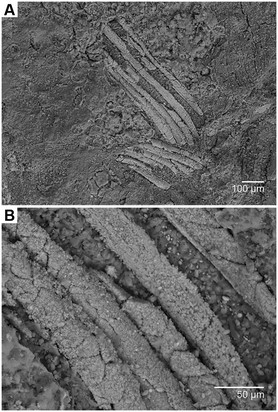@WFS,World Fossil Society,Riffin T Sajeev,Russel T Sajeev
Roughly 115 million years ago, when the ancient supercontinent Gondwana was breaking apart, a mushroom fell into a river and began an improbable journey. Its ultimate fate as a mineralized fossil preserved in limestone in northeast Brazil makes it a scientific wonder, scientists report in the journal PLOS ONE.
The mushroom somehow made its way into a highly saline lagoon, sank through the stratified layers of salty water and was covered in layer upon layer of fine sediments. In time — lots of it — the mushroom was mineralized, its tissues replaced by pyrite (fool’s gold), which later transformed into the mineral goethite, the researchers report.

Fig 1. Gondwanagaricites magnificus gen. et sp. nov.(A) Photomicrograph of holotype (URM 88000) showing general habitus. (B) Interpretive drawing of (A) with major morphological features indicated. The red box indicates the position of gills shown in Fig 2
“Most mushrooms grow and are gone within a few days,” said Illinois Natural History Survey paleontologist Sam Heads, who discovered the mushroom when digitizing a collection of fossils from the Crato Formation of Brazil. “The fact that this mushroom was preserved at all is just astonishing.
“When you think about it, the chances of this thing being here — the hurdles it had to overcome to get from where it was growing into the lagoon, be mineralized and preserved for 115 million years — have to be minuscule,” he said.
Before this discovery, the oldest fossil mushrooms found had been preserved in amber, said INHS mycologist Andrew Miller, a co-author of the new report. The next oldest mushroom fossils, found in amber in Southeast Asia, date to about 99 million years ago, he said.
“They were enveloped by a sticky tree resin and preserved as the resin fossilized, forming amber,” Heads said. “This is a much more likely scenario for the preservation of a mushroom, since resin falling from a tree directly onto the forest floor could readily preserve specimens. This certainly seems to have been the case, given the mushroom fossil record to date.”

Fig 2. Scanning electron micrographs of the gills of Gondwanagaricites magnificus gen. et sp. nov.(A) Section of preserved gills (location indicated by red box on Fig 1B). (B) close-up view of (A) showing detailed structure.
The mushroom was about 5 centimeters (2 inches) tall. Electron microscopy revealed that it had gills under its cap, rather than pores or teeth, structures that release spores and that can aid in identifying species.
“Fungi evolved before land plants and are responsible for the transition of plants from an aquatic to a terrestrial environment,” Miller said. “Associations formed between the fungal hyphae and plant roots. The fungi shuttled water and nutrients to the plants, which enabled land plants to adapt to a dry, nutrient-poor soil, and the plants fed sugars to the fungi through photosynthesis. This association still exists today.”
The researchers place the mushroom in the Agaricales order and have named it Gondwanagaricites magnificus.
Source: University of Illinois at Urbana-Champaign. “World’s oldest fossil mushroom found.” ScienceDaily. ScienceDaily, 7 June 2017. <www.sciencedaily.com/releases/2017/06/170607141349.htm>
@WFS,World Fossil Society,Riffin T Sajeev,Russel T Sajeev



 June 8th, 2017
June 8th, 2017  Riffin
Riffin  Posted in
Posted in  Tags:
Tags: 